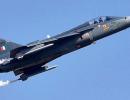HAL's HTT-40 aircraft have outperformed both Swiss Pilatus planes and the IAF's performance criteria.
Why then does the IAF prefer the Pilatus to the HTT-40?
Ajai Shukla reports.

In a coup for indigenisation, the Hindustan Turbo Trainer-40 basic trainer aircraft, designed and built by Hindustan Aeronautics Limited, has outperformed the Indian Air Force's demanding specifications.
The final qualifications -- stall and spin tests -- are proceeding well.
HAL expects full certification by June.
However, even as HAL seeks a green light for manufacturing the HTT-40, the IAF is pressing for buying 38 more Pilatus PC-7 Mark II basic trainers from Switzerland, to supplement the 75 it already operates.
This would mean building fewer Indian trainers.
There has always been a contest between the Indian and Swiss trainers.
In 2009, the defence ministry divided the IAF's requirement of 181 basic trainers between the two.
The IAF was allowed to buy 75 trainers in 'flyaway condition' from Pilatus, while HAL began developing the HTT-40 with the aim of building the rest.
The MoD stipulated that if HAL's trainer had not flown by the time the first imported trainer is delivered, the IAF could active an 'options clause', buying 38 more imported trainers and a building those many less in India.
Citing that condition, the IAF is insisting on buying 38 more Pilatus.
'In 2013,' the IAF said, 'the first PC-7 Mk II Pilatus was delivered but the HTT-40 was still not ready to fly.'
Today, the HTT-40 is not just flying, but outperforming the Pilatus, as well as the IAF's performance criteria, called the Preliminary Air Staff Requirements.
Against the IAF's demand for a top speed of 400 km per hour, the HTT-40 has been tested to 420 km per hour; it has flown to 20,200 feet, exceeding the IAF's ceiling requirement of 20,000 feet.
HTT-40 takes off and lands in just 800 metres of runway, against PSQR’s demand of 1,000 metres.
It can climb faster, turn tighter, and glide longer than the IAF requires.
Making the IAF's insistence on the Pilatus trainer even more puzzling is the fact that the original purchase of 75 PC-7 Mark 2 trainers -- as the media had widely reported -- came under the Central Bureau of Investigation's scanner for alleged links between Pilatus and alleged arms dealer, Sanjay Bhandari, who has since fled to London.
A former air force chief's role is also being investigated.
In December, at a meeting at the MoD, HAL officials strongly argued for fast-tracking HTT-40 clearance, even playing out a video of the HTT-40 smoothly handling the on-going spin testing.
Impressed by its performance, the MoD has backed the Indian trainer.
Besides performance, the Make in India policy favours choosing the HTT-40.
The Defence Procurement Procedure of 2016 gives top priority to procuring equipment in the category of 'Make -- Indian Designed, Developed and Manufactured' -- which the indigenously developed HTT-40 squarely falls into.
HAL has funded the HTT-40 development programme with Rs 500 crore (Rs 5 billion) of company funds.
It now needs to pay Honeywell -- the US firm that builds the HTT-40's engine -- Rs 180 crore (Rs 1.8 billion) to develop a digital controller for the engine.
HAL Chairman R Madhavan said he would be happy to pay from HAL's resources to save time.
"But HAL';s board, by way of abundant caution, has stipulated that the money should be paid once the IAF issues an RFP so that recovery is assured. That is why we want an RFP from the air force urgently," said Madhavan.
An air force RFP is also required for HAL to start setting up a production line for HTT-40.
Given a large number of trainers the IAF needs, Madhavan said HAL intends to deliver two HTT-40s the first year, then eight next year and, in the third year, stabilise at 10 per year.
In 2015, the MoD gave the green light for the procurement of 70 HTT-40 trainers.
But HAL said the order for 38 additional trainers would let development costs be recovered over a larger number of aircraft, lowering the price.
HAL also pointed out that an Indian trainer aircraft could be weaponised, or fitted out for a reconnaissance role.
Such modifications would be impossible with a Swiss trainer, given the tight end-user conditions imposed by Pilatus on the IAF.
Further, the HTT-40 can be maintained, overhauled, and upgraded through its 30 to 40 year service life by HAL, far more cheaply than the Swiss trainer for which the IAF would have to keep going back to Pilatus.
The IAF has already paid Pilatus Rs 300 crore (Rs 3 billion) for maintaining the PC-7 Mark II fleet for the first five years.
Now, Pilatus is demanding another Rs 550 crore (Rs 5.5 billion) for maintenance know-how.
The IAF, however, said it needed 38 more trainers so urgently that it cannot wait for the HTT-40 production line to kick in.
It says it will issue an RFP once the HTT-40 is certified.
Who wins the impending order for 38 PC-7 Mark 2 trainers -- Pilatus or HAL -- is now in the hands of the MoD.
Industry experts believe the Make in India trainer will prevail.
The Pilatus and HTT-40 are basic trainers used for training rookie pilots before they graduated onto the more advanced Kiran, and then the Hawk Advanced Jet Trainer.
Only after these three stages of training are pilots posted to combat squadrons to fly frontline fighters.










